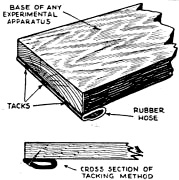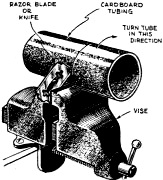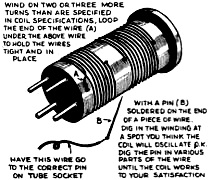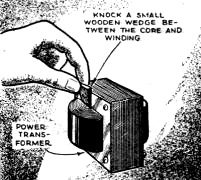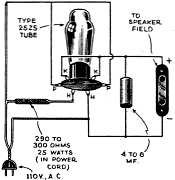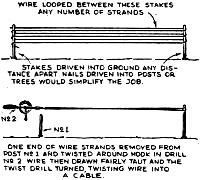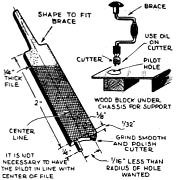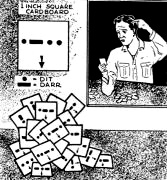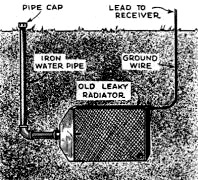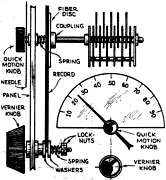$5.00 for Best Short Wave Kink
|
|
You might not have the need for a variable capacitor made from a match box and a couple strips of tin foil, but there are plenty of other "shortwave kinks" offered here that could be of use to you when the preferred part is not available. For instance, maybe a transformer exhibits an audible hum because of improper construction, or maybe a vernier dial is needed for an adjustment knob; homebrew solutions are offered for both. The adjustable capacitor idea is an "outside-and-inside-the-box" solution (pun intended) that could come in handy. In all, there are 11 tips from way back in 1935 offered by fellow radio enthusiasts, and printed in Short Wave Craft magazine. $5.00 for Best Short Wave Kink The Editor will award a five dollar prize each month for the best short-wave kink submitted by our readers. All other kinks accepted and published will be awarded eight months' subscription to Short Wave Craft. Look over these "kinks" and they will give you some idea of what the editors are looking for. Send a typewritten or ink description, with sketch, of your favorite short-wave kink to the "Kink" Editor, Short Wave Craft.
A cheap and easily constructed variable condenser can be made with a safety matchbox and a few short pieces of tinfoil. In the drawing we see that two pieces of tinfoil are used to form the two electrodes of a variable condenser. One piece of tinfoil is glued to the top of the box frame and the other piece is glued to the bottom of the sliding portion of the matchbox. A binding post is used on each of these strips of tinfoil in order to facilitate connections. If desirable, a scale can be marked on one side of the sliding member. This is clearly shown in the drawing. When the box is entirely collapsed the capacity of the condenser is maximum; by sliding the inner section of the box outward the capacity is reduced. This is a handy Instrument and many readers of "Short Wave Craft" will find various uses for it. - Gilbert S. Lowry. A short length. of rubber hose can be used to form a very simple shock absorber to eliminate vibration in a radio receiver. The drawing clearly shows that the hose is tacked or screwed to the base with the screws or tacks in such a position that they will not rest upon the table or interfere with the cushioning action of the rubber hose. This kink is especially useful with battery receivers because these tubes are usually quite a bit more microphonic than the heater type of tubes. It can also be used in conjunction with the transmitters where vibration is liable to cause a poor signal by modulating the note - Francis P. Srebro.
Probably the most difficult part of short-wave experimenting is cutting bakelite or other compound tubing the proper length for coil forms. Usually a hack-saw blade is used and in many cases a very jagged and uneven cut is made. However. by fastening a razor blade or knife blade in the vise and placing the tubing alongside of it, an accurate cut can be made. First wrap a piece of paper around the tubing in order to mark it where the cut is to be made. By squaring the edges of the paper, the mark on the tube will be perfectly square. By rotating the tube in one direction slowly and keeping the blade on the mark, accurate lengths of tubing can be cut with very little difficulty. The drawing clearly shows how this is done. - W. H. Hitchen. Many of the readers of "Short Wave Craft" have spent considerable time in wiring homemade plug-in coils. By using the scheme depicted in the drawing, the correct number of turns can easily be found. The pin is soldered to a short piece of wire and can be pushed through the insulation on any turn. When proper results are obtained, you can remove the unused turns and your coil is finished. - Howard Sig-mund. Many fans who have all-electric short-wave receivers using power transformers are troubled by a loud buzzing noise in the transformer itself. This is usually due to either loose windings or a loose section of the core. In most cases where "E" type cores are used, the center leg of the two outer laminations makes all the noise. This can be stopped quite readily by removing the frame or mounting bracket of the transformer and wedging a small piece of wood between the winding and the core. If you will refer to the accompanying drawing you will see how this piece of wood is tapered in order that it may be easily inserted. - Francis P. Srebro.
Here is a very simple method of obtaining power for the field of a dynamic speaker. Although this is not original to the writer he thought it would be of interest to the average short-wave fan. A single 25Z5 is used in a halfwave rectifying circuit. The physical drawing shows just how the connection should be made. The smoothing condenser across the output of the rectifier can be anywhere from 4 to 8 mf. and is an electrolytic having a working voltage of somewhere around 200. Heater voltage for the 25Z5 is furnished directly by the line through the 290- to 300-ohm resistor which is built right into the line cord. - W4ED. At some time or other, many short-wave fans, like myself, have been in the need of stranded antenna wire., By dismantling an old power transformer and unwinding the primary, quite a long length of stranded wire can be made. The drawings clearly show how the wire is first wrapped around two posts driven in the ground. The distance between the two will determine the approximate length of the finished cable. After the wire has been wrapped around the post remove one post and fasten the wire into a hand drill. Then by simply turning the crank handle of the drill, the wire will be twisted evenly. - William J. New. With the increase in popularity of metal panels and chassis, many home constructors will be in need of a simple, yet effective circle cutter. The drawing clearly shows how one of these can be constructed from an old file. In use this cutter saves considerable time inasmuch as a hole can be cut in less than one minute in ordinary aluminum, and two to three minutes in steel panels. - Henry Larrabee. Here is a kink that I think will help the short-wave fan who has just started to learn the code. Cut twenty-s ix one-inch squares out of' cardboard. Next, mark on them the translation, of the alphabet from A to Z in the continental code. Also, put a small arrow at the bottom of each card so one will know which way the card is to be held. We now shuffle the squares just as a pack of playing cards, and one by one take each card, identifying the letter it represents, and place it apart from the unpicked ones. In this way one gets to know the letters from their continental translation instead of forming the habit of letter to code. As soon as one knows the letters, cards of the numbers can be made. - Norman Esplin.
Being unable to obtain a good ground, I finally hit upon the idea illustrated in the accompanying drawing. I obtained an old radiator which had a good many leaks in it. After fastening a pipe to the filling hole on the radiator and soldering a wire to the other end. I buried the entire assembly in the ground four or five feet below the surface. I then proceeded to fill the radiator with water. This, due to the holes in the radiator, seeped outward and made the earth surrounding the radiator quite moist lowering the ground resistance considerably. The lead from this ground to the receiver was kept as short as possible, and really excellent results have been obtained. I am passing this information along to the readers of "Short Wave Craft" in the hope that it will be of material benefit to them. - Edwin Boon. Nearly every short-wave fan who builds his own equipment gets the greatest amount of fun out or building it rather than listening to the short-wave stations. The experimenter will find this dial easy to construct and very handy in operation. There are two knobs, one which is attached directly to the main shaft and gives a direct drive for rapid tuning, and another knob which drives the outer edge of the large disc for vernier tuning. All the parts of this simple vernier dial can be found in the shack junk box. - G. E. Tovey.
Posted April 20, 2022 (original 4/8/2015) |
|


